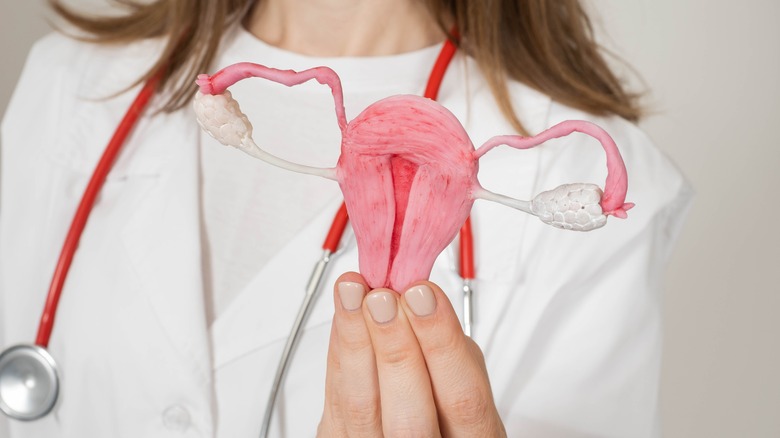Really Weird Facts About A Woman's Body
Let's face it: The human body is pretty weird. The female body, in particular, has long been "misunderstood, maligned, and under-researched," according to The Irish Times. From menstrual cramps to the G-spot to weirdly acute eyesight, female biology is both a marvel and a mystery. Many of the puzzles of the feminine form are due to the complex changes in women's bodies during pregnancy, breastfeeding, and menopause, according to the outlet.
The ways the female body differs from the male body are so intriguing that scientists have created an entire journal, titled Biology of Sex Differences, to study and debate the details of how the bodies of the fairer sex are different from their male counterparts. The editorial board asserts that the journal "focuses on sex differences in all aspects of an individual or organism: from molecules to behavior and from studies of cellular function to clinical research studies."
Scientific breakthroughs are only half the battle, though. Getting the word out about new developments in medical science, biology, and fertility research — and figuring out how to educate women on their own bodies — has long been a challenge (via Pearson). So it's in that spirit that we offer you some of the weirdest and most intriguing facts about the female body, because women deserve to be educated on every aspect of their health — the good, the bad, and the strange.
Sex can improve women's immune systems
According to a study published in Psychological Reports, one easy way women can improve their immune systems is by having more sex. The authors report that women who have sex more than once a week boast 30% more immunoglobulin A (otherwise known as IgA antibodies) in their immune systems compared to other women who have less sex.
Found in your mouth and nose, these antibodies are crucial to your health, as they're one of the first defense mechanisms deployed when unwanted germs try to enter the body. Boosting the amount of IgA antibodies in your system is a key strategy to improving overall immune system health. However, Gail Saltz, MD, an associate professor of psychiatry at the New York Presbyterian Hospital, Weill-Cornell School of Medicine, warns in Health magazine that increasing the frequency of sex can't be the only defense against sickness.
"There have been a couple of very small studies suggesting that chemicals related to the body's immune system are impacted by sexual stimulation," she says. "To my knowledge, no study says specifically that masturbation [or sex] boosts the immune system in a way that prevents or helps fight off infection." So get those booster shots, ladies — sex is only the cherry on top of your health regimen.
The clitoris can change as women get older
"They're weird, fabulous little creatures," according to Alli Sebastian Wolf (via The Guardian). It's not some exotic wildlife creature Wolf is discussing here; it's the clitoris — that part of the vulva that famously only exists to give women pleasure (via Planned Parenthood).
Wolf, an Australian-based artist, was featured in The Guardian in 2017 for her eye-catching sculpture titled Glitoris, crafted with the intent of educating the world on the intricacies of women's reproductive biology. Wolf's website describes Glitoris as "a giant sparkling 100:1 scale anatomical model of a clitoris — one of the most misunderstood parts of the human body."
Misunderstood though it may be, what scientists do know about the clitoris is fascinating. One of the strangest facts is that it can grow and shrink as women age. According to Susan Maayah, M.D., a health expert from the Palo Alto Medical Foundation, "The clitoris never actually disappears, but it can become smaller over time after the loss of circulating female hormones with menopause. This is part of a normal condition with aging called urogenital atrophy" (via Sutter Health).
Conversely, Rebecca Chalker, Ph.D. has reported that it also isn't uncommon for the clitoris to grow in length over the years. Chalker, author of "The Clitoral Truth: The Secret World at Your Fingertips," told Health magazine that a woman who notices her clitoris growing in size is simply experiencing a normal biological response to her body's change in hormone levels.
Women have faster circadian rhythms than men
Have you noticed that women seem to tackle the day earlier than men? Well, science tells us that's no coincidence. According to a research article published in The Proceedings of the National Academy of Sciences (PNAS), "The circadian rhythms of melatonin and body temperature are set to an earlier hour in women than in men, even when the women and men maintain nearly identical and consistent bedtimes and wake times. Moreover, women tend to wake up earlier than men and exhibit a greater preference for morning activities than men."
Leading academics have hypothesized that there are also social factors at play when it comes to the differences in women's and men's sleep schedules. Women's unique body clocks have been known to lead to cases of insomnia, and it doesn't help that wives and mothers are traditionally tasked with the bulk of domestic household chores.
Harvard Medical School's sleep researcher, Charles Czeisler, M.D., Ph.D., told NPR, "I think many women are chronically sleep-deprived because of their work obligations: They're taking care of children, helping them with homework — whatever is happening that can only be done in the evening hours. That precludes many women from getting to bed early enough to get a full, sound night of sleep."
Females are the bigger criers
Women cry for a number of reasons: There are period hormones, angry tears, and, of course, those heartstring-tugging Hallmark commercials. However, scientific reports spanning all the way back to the 1960s have found that females' propensity to shed tears may not be 100% within their control.
Dr. Geoffrey Goodfellow from the Illinois College of Optometry, told The Cut, "There are several studies over the years that have shown that men have larger tear ducts in their eyes, so that it is less likely for the tears to well up to the point of spilling over the eyelid onto the cheek."
One of the oldest studies that confirms this physical difference was conducted by Richard H. Post from the Department of Human Genetics at the University of Michigan's Medical School. Though much of the science of Post's 1960s study would be called faulty by modern researchers, his observation of women's smaller tear ducts has indeed stood the test of time.
In his 2013 book "Why Only Humans Weep: Unravelling the Mysteries of Tears," Ad Vingerhoets summarizes from the self-reports of his test subjects that "women cry 30 to 64 times a year, whereas men cry just six to 17 times per year" (via The Cut).
Women can be born with two uteruses
Have you ever heard of uterus didelphys? Chances are, probably not. This is a pretty rare affliction where a baby girl is born with two uteruses. According to the Cleveland Clinic, uterus didelphys "only affects about 0.3% of the population," making it "one of the least common uterine abnormalities."
Often just called double uterus, the condition is caused when a female fetus experiences trouble with the Müllerian ducts. Named after the German psychologist Johannes Peter Müller, the Müllerian ducts are tubes that eventually fuse together to form female reproductive organs, including the cervix, uterus, fallopian tubes, and upper vagina. However, sometimes these biological instructions get misread during the developmental period, and the tubes meant to form the baby girl's uterus are unable to properly fuse together. The result is uterus didelphys, where the tubes form two separate uteruses.
Baby girls who are born with this condition are not always diagnosed right away; it's often only later in life when they report feeling intense pre- or post-menstrual cramps and a series of exams reveals the diagnosis. According to Nationwide Children's Hospital, these exams might include an ultrasound, MRI, sonohysterogram, or hysterosalpingography.
The vagina has an acidity level on par with wine and coffee
You might have learned about pH levels in middle-school science class, but did you know that maintaining a certain pH level is a crucial part of good vaginal health?
According to Healthline, a normal vaginal pH level ranges from 3.8 and 4.5, which is in the moderately acidic category. Weirdly, this acidity level is nearly the same as a cup of black coffee or a glass of wine. As Kate MacDonnell with Coffee Affection reported, "Coffee, in fact, generally has a pH of less than 5 (out of 7). This means coffee is acidic, and the only way to make it less so is to somehow change the balance of hydrogen ions." Noelle Hale with Wine Enthusiast also notes that a glass of wine typically ranges from 3 to 4 on the pH scale.
The foods and drinks a woman consumes can also have a huge effect on her vaginal health. According to Healthline, eating a diet rich in probiotics and fermented foods — or taking a probiotic supplement — can help contribute to a proper pH balance.
Men have thicker skin than women – literally
Skin is important to women. According to a report published by Groupon Merchant in 2017, the company found that women spend an average of $313 each month on their appearance — which totals up to $3,756 per year or $225,360 in a lifetime (via Byrdie).
There is no doubt plenty of societal pressure at play here, with media and unrealistic beauty standards pushing women to buy more and more products in an effort to look young. However, science says there may also be a biological reason that women are more in tune with the appearance of their skin. According to a study published in the International Journal of Women's Dermatology, "the skin parameters of hydration, transepidermal water loss, sebum, microcirculation, pigmentation, and thickness are generally higher in men, but skin pH is higher in women."
In layman's terms, male skin is about 20% thicker than female skin, and appears tighter and firmer. It also has a higher amount of collagen (via Eucerin). This higher collagen count means that men's skin will biologically show fewer signs of aging than women's skin — not to mention the extra exfoliation boost that men get from regular facial shaving.
Spiders and women don't mix
According to ABC in Australia, research shows that up to 90% of all arachnophobes are women. But what is it about these eight-legged creatures that send more women than men jumping into their seats and screaming SOS? Researchers have reported that there could be a biological reason behind this strange gender difference.
Pinpointing "female sex hormones" as the main culprit behind women's arachnophobia, scientists at the University of New South Wales are using a series of exposure therapy treatments to explore whether women are truly more prone to a fear of spiders and less responsive to anxiety treatments at certain periods of their menstrual cycles (via ABC).
Led by development psychologist David Rakison, a Carnegie Mellon experiment consisted of a series of psychological tests conducted on multiple groups of babies separated by gender (via New Scientist). After showing each group a series of basic photographs, including photos of flowers, spiders, and human faces, Rakison's team concluded that girls are more likely than boys to be scared of dangerous animals.
Women can see more colors
According to a 2012 study conducted by Israel Abramov at CUNY Brooklyn College, women on average have a larger color vocabulary than their male counterparts. Abramov's report comes from an experiment where he asked male and female test subjects to dissect colors that looked almost identical and to try their best at labeling each color's percentage of red, yellow, green, and blue. The results showed that women were much better at distinguishing minor differences in hues (via Biology of Sex Differences).
As National Geographic puts it, "the grass is almost always greener to women than to men, to whom verdant objects appear a bit yellower." The evolutionary reason for this dates all the way back to our caveman (or, rather, cavewoman) days, according to scientists. National Geographic goes on to report that "the vision findings support the so-called hunter-gatherer hypothesis, which argues that the sexes evolved distinct psychological abilities to fit their prehistoric roles."
While women may be much better than men at distinguishing "salmon pink" from "cardinal red," this leftover biology also means that men are much better at recognizing "rapidly moving stimuli," presumably due to the hunter's need to recognize potential predators or prey (via the New Zealand Herald).
The human vagina and sharks have something in common
What could human females and sharks possibly have in common? Fear factor, powers of intimidation? No, weirdly enough, the answer lies in a little-known molecule known as squalene (via the McGill University Office for Science and Society).
In sharks, squalene is a naturally occurring oil found in the liver. In humans, squalene is the substance that lubricates the vagina when the woman becomes aroused. It's a bit of a mystery why this compound is found in these two specific organs, but, according to McGill, the people who live on the Japanese peninsula of Izu consider squalene to be a cure-all for a range of illnesses and conditions.
Additionally, squalene is so effective as an emollient (basically, any substance that acts as a moisturizer) that multiple skincare companies include an alternatively sourced version of the original compound as an ingredient in their face oils and creams (via the American Chemical Society). In chronicling some of the best squalene products on the market, the Independent described this little molecule as a "hardworking ingredient" that can result in softer, more supple, more radiant skin.
We no longer need men to procreate
The scientific name for it is "parthenogenesis," but we'll just call it a miracle — it's the process by which female organisms can create embryos without the assistance of male sperm (via the European Commission). According to an EU Community Research and Development Information Service (CORDIS) report, the process has been observed in creatures such as mice and monkeys, with scientists predicting that viable human pregnancies without men could be in our future as well.
In 2018, the Courier Mail interviewed a leading fertility expert from Queensland, Australia about this phenomenon (via Earth.com). On the potential ramifications of this development, Dr. David Molloy said, "It would mean that heterosexual couples where the man has low-quality sperm, and women couples, can have their own genetic child. I think it will be possible to fertilize an egg with a set of half chromosomes and targeted gene editing."
As exciting as this may sound for many women, multiple researchers have also warned that there is still much work to be done before parthenogenesis can become a reality for humankind. "The concept is intriguing for human reproduction, particularly for same-sex couples. But there are far too many uncertainties at present to attempt such an approach for many years to come," Professor for Reproductive and Periconceptual Medicine Robert Norman told the Daily Mail. Regardless, it's hard not to marvel at the fact that the female body is capable of such biological wonders.











